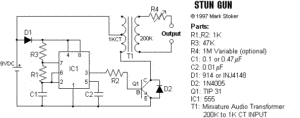 Stun Guns work through modern electronics and as explored in the stun gun page: https://www.securitydefenseweapons.com/learn-about-stun-guns.html we discussed many aspects of the stun gun and it’s electronics. I came across the article below that goes in to a much deeper exploration of a stun gun and it’s electronics.
Stun Guns work through modern electronics and as explored in the stun gun page: https://www.securitydefenseweapons.com/learn-about-stun-guns.html we discussed many aspects of the stun gun and it’s electronics. I came across the article below that goes in to a much deeper exploration of a stun gun and it’s electronics.
Conventional stun guns have a fairly simple design. They are about the size of a flashlight, and they work on ordinary 9-volt batteries.
The batteries supply electricity to a circuit consisting of various electrical components. The circuitry includes multiple transformers, components that boost the voltage in the circuit, typically to between 20,000 and 150,000 volts, and reduce the amperage. It also includes a oscillator, a component that fluctuates current to produce a specific pulse pattern of electricity. This current charges a capacitor. The capacitor builds up a charge, and releases it to the electrodes, the “business end” of the circuit.
The electrodes are simply two plates of conducting metal positioned in the circuit with a gap between them. Since the electrodes are positioned along the circuit, they have a high voltage difference between them. If you fill this gap with a conductor (say, the attacker’s body), the electrical pulses will try to move from one electrode the other, dumping electricity into the attacker’s nervous system.
Stun guns and Taser are excellent self defense tools that are a product of technology and the electronic age. Much like the phaser on Star Trek..

